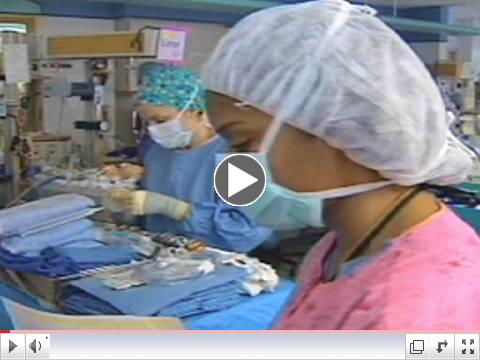|
Underwriter
|

NEED MEDICAL OFFICE SPACE? CALL (954) 346-8200 Ext. 201 __________________
|
A few thoughts on Cystic Fibrosis (CF)
| |
CF remains a life-shortening disease in spite of recent improvements in survival age. Early in infancy even when asymptomatic, infants with CF have an intense inflammatory response in their airways. Neutrophil proteases are on the one hand protective enhancing bacterial killing and on the other destructive, with accumulating neutrophil elastase impairing ciliary function, bacterial clearance and destroying the structure of the peripheral airways. It appears that even with the use of 2 or more intravenous antibiotics 25% of post-pseudomonal infection results in loss of lung function.
Bronchiectasis in CF may develop as early as 10 weeks of age and is persistent and progressive. Prevalence (3 mths-3 yrs.) ranges from 29.3% to 61.5%. Risk factors include meconium ileus, early (<3 months) respiratory symptoms, free neutrophil elastase activity in bronchoalveolar lavage and gas trapping on expiratory CT of the lung.
New England Journal of Medicine Reference #1
New England Journal of Medicine Reference #2
Pediatric Pulmonology
|
|
Genetics of "port-wine skin staining" & Sturgeon-Weber syndrome (SWS)
| |
Port-wine skin stains (nevus flammeus) are birth marks that can occur anywhere in the body but are most commonly found on the skin of the face, neck, scalp, arm or legs.
SWS is a rare sporadic congenital neurocutaneous developmental disorder characterized by a port-wine stain over the ophthalmic branch of the trigeminal nerve, plus abnormal vessels involving the meninges, brain and spinal cord.
The whole-genome sequence of DNA from patients with port-wine stains, SWS or neither identifies a non
synonymous (changes the sequence of amino acids in a protein) single-nucleotide variant (c.548G→A, p.arg183Gin) in the gene (GNAQ) which affects 92% and 88% respectively of patients with port-wine skin stains or SWS.
New England Journal of Medicine
|
|
Updates in Pediatrics is brought to you by:
|

______________
|
|
|
Adolescent idiopathic scoliosis ( AIS ) progression & osteopenia
Approximately 3% of the adolescent population have AIS. The association between AIS and osteopenia has been previously described. Initial bone mineral density (BMD) may be a prognostic factor in delineating outcomes of AIS patients treated with braces.
In general, girls with a larger Cobb angle (a measure of coronal plane curve deformity) which is primarily thoracic, a lower Risser Grade (less mature skeleton) who are premenstrual and who have a significant lower BMD of lumbar spines L2-L4 will have progressive AIS.
Osteopenia appears to be an independent risk factor for curve progression in AIS girls.
Journal of Pediatric Orthopedics
|
|
Is "stability" required prior to surgery for congenital diaphragmatic hernia (CDH)?
It is common practice to delay surgery for CDH to achieve respiratory/hemodynamic stability.
A retrospective analyses of data which divided patients undergoing repair of CDH into those meeting strict (FiO2<0.60, conventional ventilation, preductal oxygen saturation > 92%, no inotropes or vasodilators) or lenient criteria prior to surgery, indicates that survival predictors include prenatal liver position, pre-operative oxygen and inotropic support, plus non-conventional ventilation.
While most survivors of CDH surgery are those who meet strict preoperative criteria, many survivors do not. Surgery should be offered to all CDH patients irrespective of stability status. Surgical complications in survivors are common, may be asymptomatic and may occur many years later.
Journal of Pediatric Surgery Reference #1
Journal of Pediatric Surgery Reference #2
|
Video Feature
 | |
Congenital Diaphragmatic Hernia (CDH) - Surgical Repair - Fetal Surgery & Treatment
|
The Children's Hospital of Philadelphia via YouTube
|
Vitamin D deficiency (VDD), gastrointestinal & ear infections
"Vitamin D is a group of fat soluble secosteroids responsible for enhancing intestinal absorption of calcium and phosphate." It also activates the innate immune systems. Deficiency may be associated with prematurity, rickets in children (osteomalasia in adults) and increased mortality from cancer, perhaps cardiovascular disease and multiple sclerosis. In humans the most important compounds of this group are Vitamin's D3 and D2 (collectively known as calciferols) which are generally measured in the blood as 25-hydroxyvitamin D (25(OH)D).
475 Colombian children (mean age 8.9 years) had random samples of 25(OH)D drawn and were then followed for an academic year with episodes of diarrhea, with/without vomiting, cough with fever and ear ache documented.
10% of school age children may be Vitamin D deficient. VDD appears to be associated with an increased rate of diarrhea with vomiting and ear ache/discharge with fever.
Pediatric Infectious Disease Journal
|
A unilateral dilated pupil
Facial lacerations are quite common. In the Emergency Department local anesthetics and sedation facilitate repair; topical anesthetics now reducing the need for injectable products.
A local side effect of a widely used topical gel anesthetic (containing 4% lidocaine, epinephrine 0.1% tetracaine 0.5%-LET) though valuable and efficacious when utilized to repair a lacerated eye lid may result in a unilateral dilated pupil.
Pediatric Emergency Care
|
Underwriting Opportunities
|
With a circulation of over 4,900, Updates in Pediatrics offers an excellent opportunity to promote your brand at affordable rates.
|
|
|